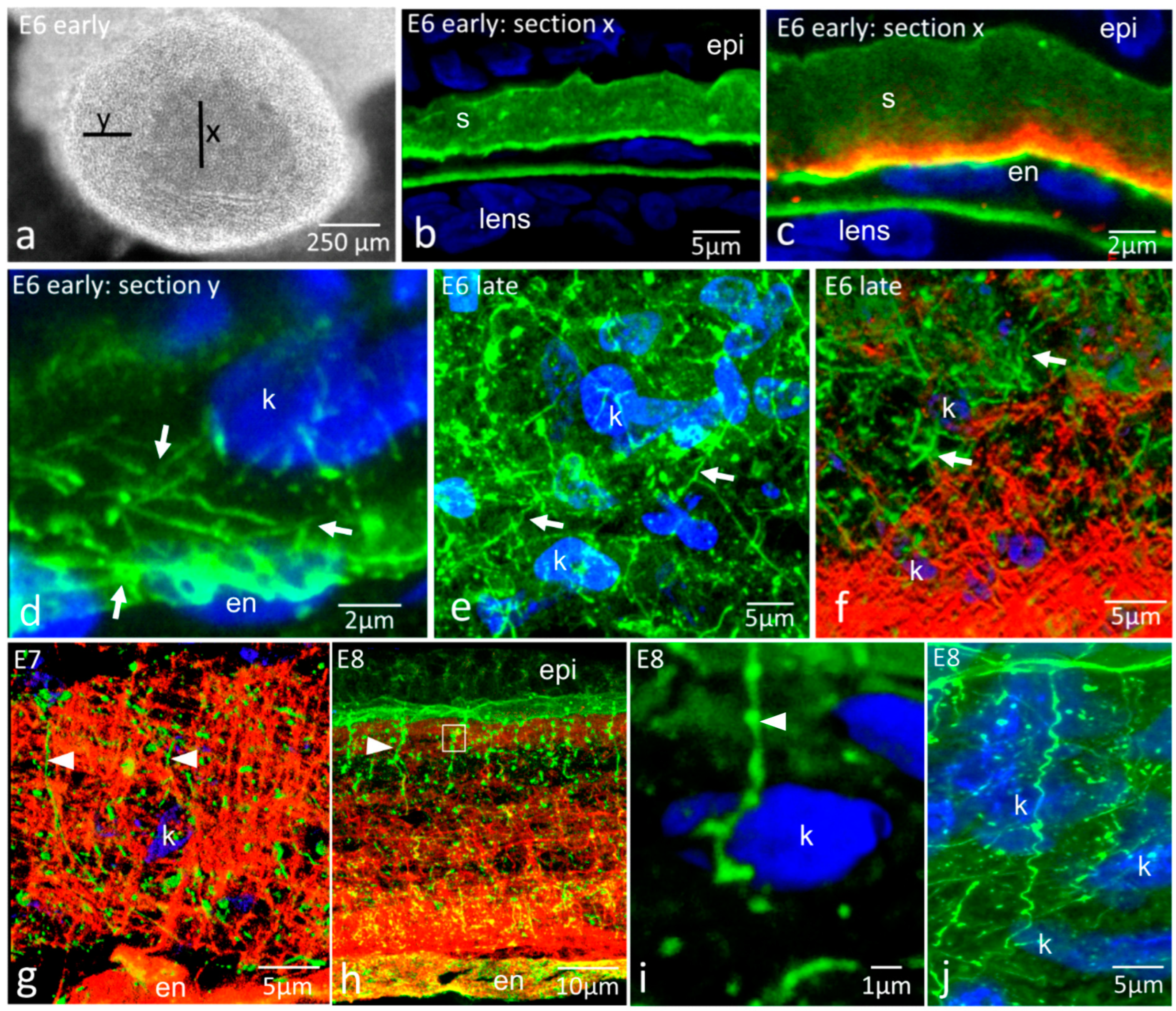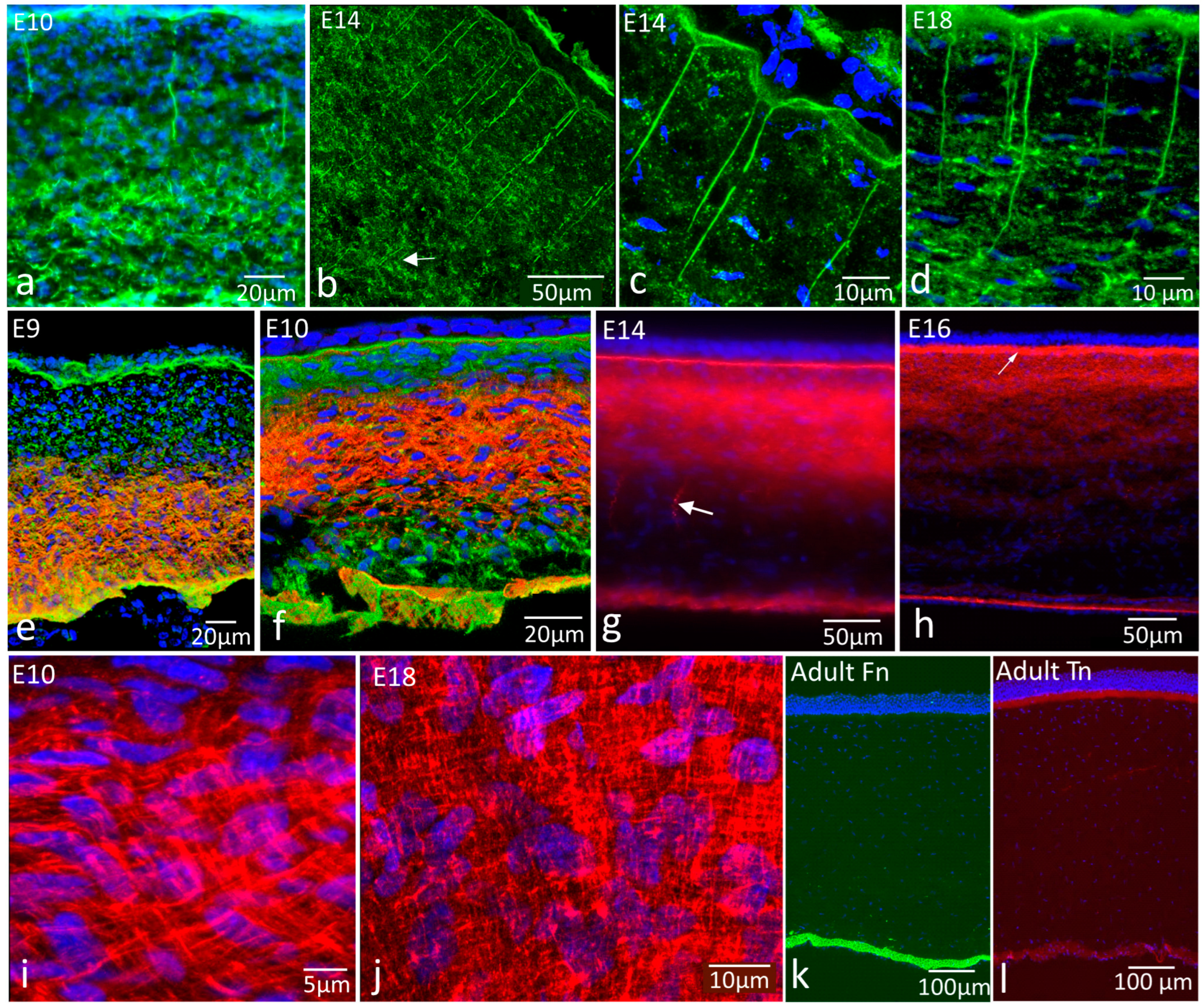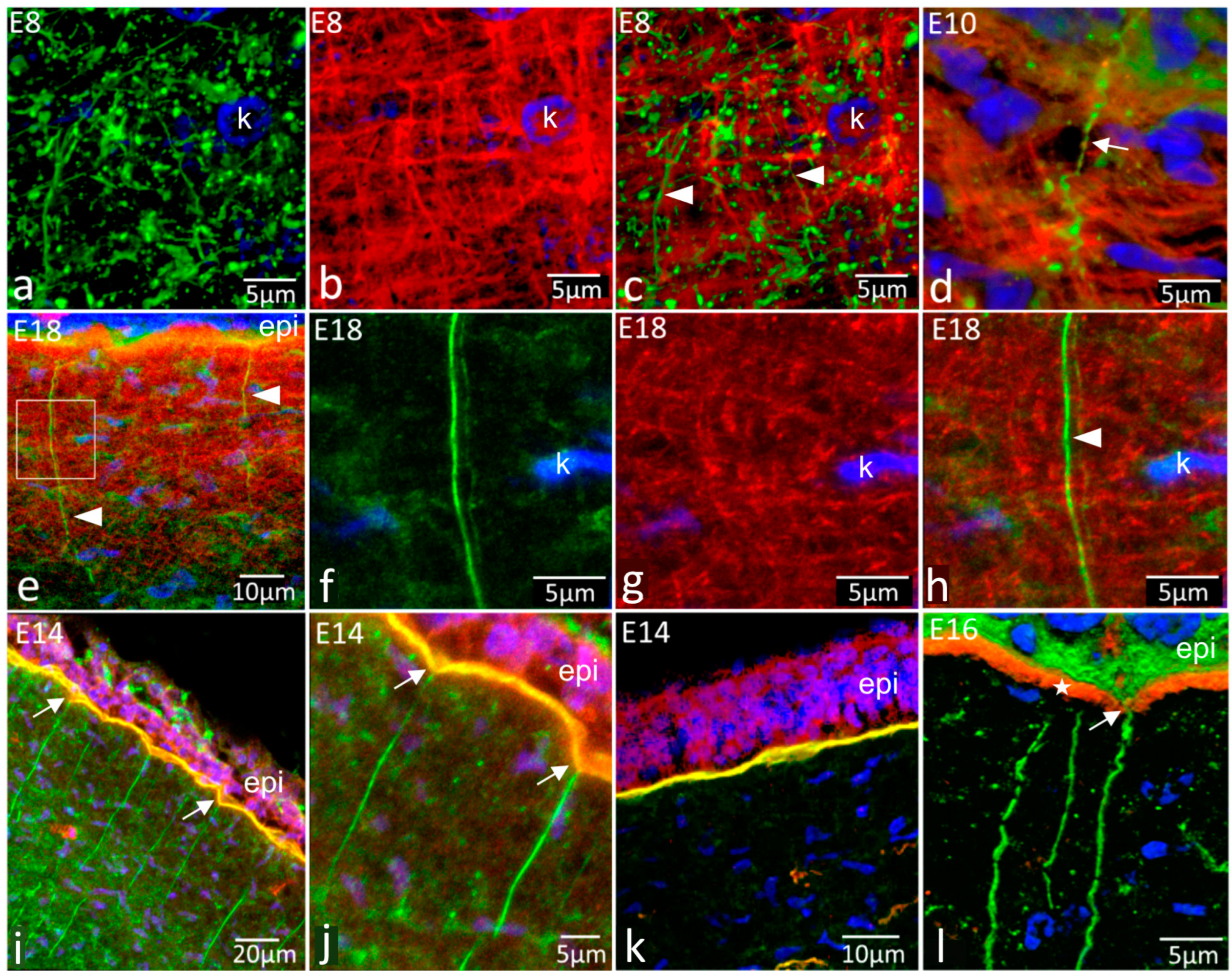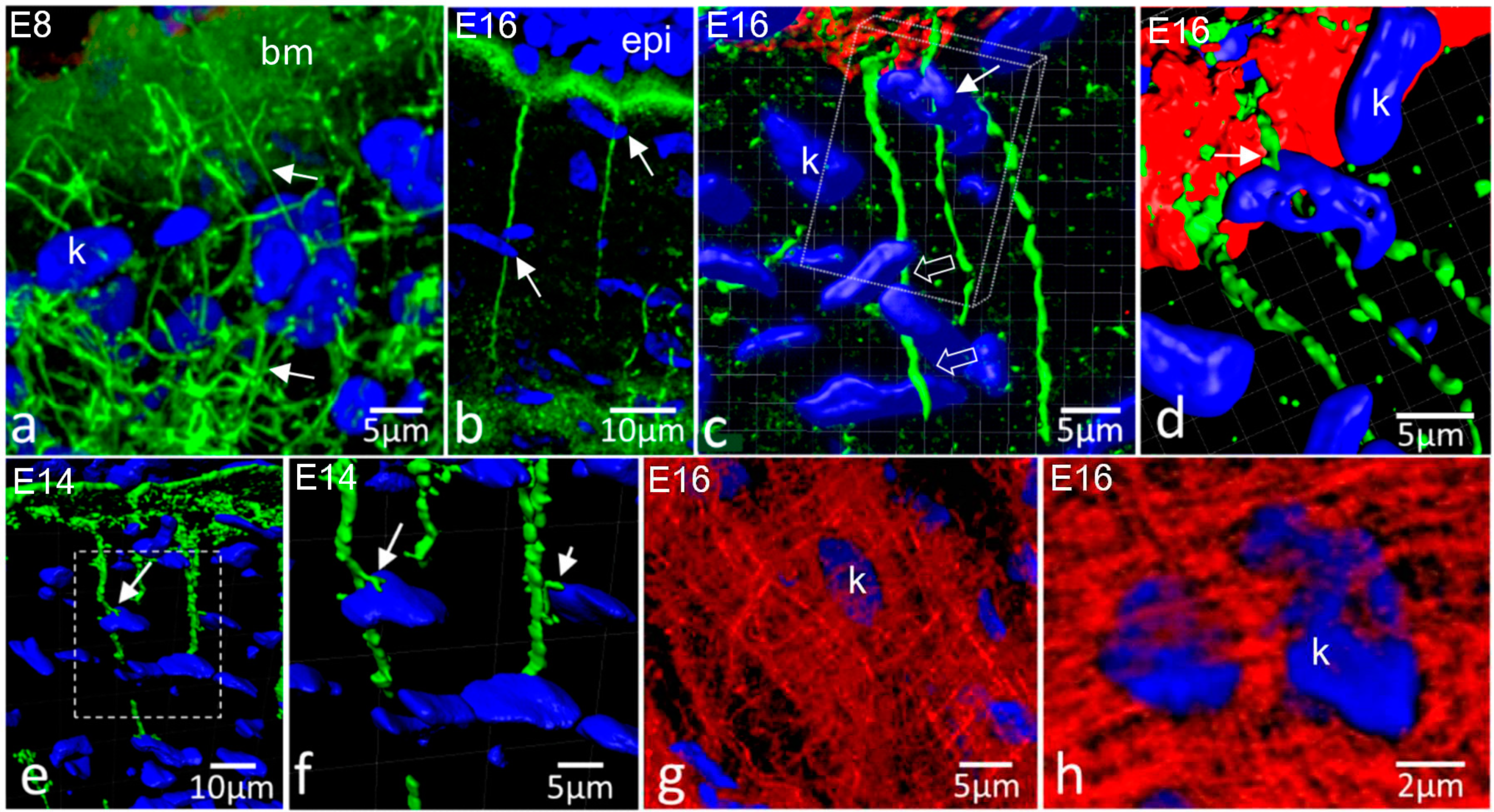Developmental Changes in Patterns of Distribution of Fibronectin and Tenascin-C in the Chicken Cornea: Evidence for Distinct and Independent Functions during Corneal Development and Morphogenesis
Abstract
1. Introduction
2. Results
2.1. Early Development: E6–E8
2.2. Middle to Late Development: E9–Adult
2.3. Fibronectin and Tenascin Interaction and Relationship with the Epithelial Basement Membrane
2.4. Relationships of Fibronectin and Tenascin with Keratocytes
3. Discussion
4. Materials and Methods
4.1. Tissue Acquisition—Chick Embryos
4.2. Tissue Processing
4.3. Immunohistochemistry
4.4. Fluorescence and Confocal Microscopy
Author Contributions
Funding
Data Availability Statement
Acknowledgments
Conflicts of Interest
References
- Koudouna, E.; Winkler, M.; Mikula, E.; Juhasz, T.; Brown, D.J.; Jester, J.V. Evolution of the vertebrate corneal stroma. Prog. Retin. Eye Res. 2018, 64, 65–76. [Google Scholar] [CrossRef]
- Abahussin, M.; Hayes, S.; Knox Cartwright, N.E.; Kamma-Lorger, C.S.; Khan, Y.; Marshall, J.; Meek, K.M. 3D collagen orientation study of the human cornea using X-ray diffraction and femtosecond laser technology. Investig. Ophthalmol. Vis. Sci. 2009, 50, 5159–5164. [Google Scholar] [CrossRef] [PubMed]
- Hay, E.D.; Revel, J.P. Fine structure of the developing avian cornea. Monogr. Dev. Biol. 1969, 1, 1–144. [Google Scholar] [PubMed]
- Trelstad, R.L.; Coulombre, A.J. Morphogenesis of the collagenous stroma in the chick cornea. J. Cell Biol. 1971, 50, 840–858. [Google Scholar] [CrossRef]
- Bard, J.B.; Hay, E.D. The behavior of fibroblasts from the developing avian cornea. Morphology and movement in situ and in vitro. J. Cell Biol. 1975, 67, 400–418. [Google Scholar] [CrossRef] [PubMed]
- Trelstad, R.L. The Golgi apparatus in chick corneal epithelium: Changes in intracellular position during development. J. Cell Biol. 1970, 45, 34–42. [Google Scholar] [CrossRef]
- Grinnell, F.; Feld, M.; Minter, D. Fibroblast adhesion to fibrinogen and fibrin substrata: Requirement for cold-insoluble globulin (plasma fibronectin). Cell 1980, 19, 517–525. [Google Scholar] [CrossRef]
- Stepp, M.A.; Zhu, L. Upregulation of alpha 9 integrin and tenascin during epithelial regeneration after debridement in the cornea. J. Histochem. Cytochem. 1997, 45, 189–201. [Google Scholar] [CrossRef]
- Ljubimov, A.V.; Saghizadeh, M.; Spirin, K.S.; Khin, H.L.; Lewin, S.L.; Zardi, L.; Bourdon, M.A.; Kenney, M.C. Expression of tenascin-C splice variants in normal and bullous keratopathy human corneas. Investig. Ophthalmol. Vis. Sci. 1998, 39, 1135–1142. [Google Scholar]
- Saghizadeh, M.; Khin, H.L.; Bourdon, M.A.; Kenney, M.C.; Ljubimov, A.V. Novel splice variants of human tenascin-C mRNA identified in normal and bullous keratopathy corneas. Cornea. 1998, 17, 326–332. [Google Scholar] [CrossRef]
- Singh, P.; Schwarzbauer, J.E. Fibronectin and stem cell differentiation-lessons from chondrogenesis. J Cell Sci. 2012, 125, 3703–3712. [Google Scholar] [CrossRef]
- Missirlis, D.; Haraszti, T.; Kessler, H.; Spatz, J.P. Fibronectin promotes directional persistence in fibroblast migration through interactions with both its cell-binding and heparin-binding domains. Sci. Rep. 2017, 7, 3711. [Google Scholar] [CrossRef] [PubMed]
- Stepp, M.A.; Daley, W.P.; Bernstein, A.M.; Pal-Ghosh, S.; Tadvalkar, G.; Shashurin, A.; Palsen, S.; Jurjus, R.A.; Larsen, M. Syndecan-1 regulates cell migration and fibronectin fibril assembly. Exp. Cell Res. 2010, 316, 2322–2339. [Google Scholar] [CrossRef] [PubMed]
- Sugioka, K.; Yoshida, K.; Kodama, A.; Mishima, H.; Abe, K.; Munakata, H.; Shimomura, Y. Connective tissue growth factor cooperates with fibronectin in enhancing attachment and migration of corneal epithelial cells. Tohoku J. Exp. Med. 2010, 222, 45–50. [Google Scholar] [CrossRef] [PubMed]
- Singh, P.; Carraher, C.; Schwarzbauer, J.E. Assembly of fibronectin extracellular matrix. Annu. Rev. Cell Dev. Biol. 2010, 26, 397–419. [Google Scholar] [CrossRef]
- Erickson, H.P.; Carrell, N.; McDonagh, J. Fibronectin molecule visualized in electron microscopy: A long, thin, flexible strand. J. Cell Biol. 1981, 91, 673–678. [Google Scholar] [CrossRef]
- Pelta, J.; Berry, H.; Fadda, G.C.; Pauthe, E.; Lairez, D. Statistical conformation of human plasma fibronectin. Biochemistry 2000, 39, 5146–5154. [Google Scholar] [CrossRef] [PubMed]
- Kimizuka, F.; Ohdate, Y.; Kawase, Y.; Shimojo, T.; Taguchi, Y.; Hashino, K.; Goto, S.; Hashi, H.; Kato, I.; Sekiguchi, K.; et al. Role of type III homology repeats in cell adhesive function within the cell-binding domain of fibronectin. J. Biol. Chem. 1991, 266, 3045–3051. [Google Scholar] [CrossRef]
- Li, F.; Redick, S.D.; Erickson, H.P.; Moy, V.T. Force measurements of the alpha5beta1 integrin-fibronectin interaction. Biophys. J. 2003, 84, 1252–1262. [Google Scholar] [CrossRef]
- Krammer, A.; Lu, H.; Isralewitz, B.; Schulten, K.; Vogel, V. Forced unfolding of the fibronectin type III module reveals a tensile molecular recognition switch. Proc. Natl. Acad. Sci. USA 1999, 96, 1351–1356. [Google Scholar] [CrossRef]
- Klotzsch, E.; Smith, M.L.; Kubow, K.E.; Muntwyler, S.; Little, W.C.; Beyeler, F.; Gourdon, D.; Nelson, B.J.; Vogel, V. Fibronectin forms the most extensible biological fibers displaying switchable force-exposed cryptic binding sites. Proc. Natl. Acad. Sci. USA 2009, 106, 18267–18272. [Google Scholar] [CrossRef]
- Chiquet-Ehrismann, R.; Mackie, E.J.; Pearson, C.A.; Sakakura, T. Tenascin: An extracellular matrix protein involved in tissue interactions during fetal development and oncogenesis. Cell 1986, 47, 131–139. [Google Scholar] [CrossRef]
- Midwood, K.S.; Orend, G. The role of tenascin-C in tissue injury and tumorigenesis. J. Cell Commun. Signal. 2009, 3, 287–310. [Google Scholar] [CrossRef]
- Tucker, R.P.; Chiquet-Ehrismann, R. Tenascin-C: Its functions as an integrin ligand. Int. J. Biochem. Cell Biol. 2015, 65, 165–168. [Google Scholar] [CrossRef] [PubMed]
- Swindle, C.S.; Tran, K.T.; Johnson, T.D.; Banerjee, P.; Mayes, A.M.; Griffith, L.; Wells, A. Epidermal growth factor (EGF)-like repeats of human tenascin-C as ligands for EGF receptor. J. Cell Biol. 2001, 154, 459–468. [Google Scholar] [CrossRef] [PubMed]
- Wallner, K.; Li, C.; Shah, P.K.; Wu, K.J.; Schwartz, S.M.; Sharifi, B.G. EGF-Like domain of tenascin-C is proapoptotic for cultured smooth muscle cells. Arterioscler. Thromb. Vasc. Biol. 2004, 24, 1416–1421. [Google Scholar] [CrossRef]
- Cai, J.; Lu, W.; Du, S.; Guo, Z.; Wang, H.; Wei, W.; Shen, X. Tenascin-C modulates cell cycle progression to enhance tumour cell proliferation through AKT/FOXO1 signalling in pancreatic cancer. J. Cancer. 2018, 9, 4449–4462. [Google Scholar] [CrossRef]
- Midwood, K.; Sacre, S.; Piccinini, A.M.; Inglis, J.; Trebaul, A.; Chan, E.; Drexler, S.; Sofat, N.; Kashiwagi, M.; Orend, G.; et al. Tenascin-C is an endogenous activator of Toll-like receptor 4 that is essential for maintaining inflammation in arthritic joint disease. Nat. Med. 2009, 15, 774–780. [Google Scholar] [CrossRef]
- Huang, W.; Chiquet-Ehrismann, R.; Moyano, J.V.; Garcia-Pardo, A.; Orend, G. Interference of tenascin-C with syndecan-4 binding to fibronectin blocks cell adhesion and stimulates tumor cell proliferation. Cancer Res. 2001, 61, 8586–8594. [Google Scholar]
- Greiling, D.; Clark, R.A. Fibronectin provides a conduit for fibroblast transmigration from collagenous stroma into fibrin clot provisional matrix. J. Cell Sci. 1997, 100, 861–870. [Google Scholar] [CrossRef]
- Miron-Mendoza, M.; Graham, E.; Manohar, S.; Petroll, W.M. Fibroblast-fibronectin patterning and network formation in 3D fibrin matrices. Matrix Biol. 2017, 64, 69–80. [Google Scholar] [CrossRef] [PubMed]
- Kaplony, A.; Zimmermann, D.R.; Fischer, R.W.; Imhof, B.A.; Odermatt, B.F.; Winterhalter, K.H.; Vaughan, L. Tenascin Mr 220,000 isoform expression correlates with corneal cell migration. Development 1991, 112, 605–614. [Google Scholar] [CrossRef]
- Tucker, R.P. The distribution of J1/tenascin and its transcript during the development of the avian cornea. Differentiation 1991, 48, 59–66. [Google Scholar] [CrossRef] [PubMed]
- Maseruka, H.; Ridgway, A.; Tullo, A.; Bonshek, R. Developmental changes in patterns of expression of tenascin-C variants in the human cornea. Investig. Ophthalmol. Vis. Sci. 2000, 41, 4101–4107. [Google Scholar]
- Fitch, J.M.; Birk, D.E.; Linsenmayer, C.; Linsenmayer, T.F. Stromal assemblies containing collagen types IV and VI and fibronectin in the developing embryonic avian cornea. Dev. Biol. 1991, 144, 379–391. [Google Scholar] [CrossRef]
- Linsenmayer, T.F.; Fitch, J.M.; Gordon, M.K.; Cai, C.X.; Igoe, F.; Marchant, J.K.; Birk, D.E. Development and roles of collagenous matrices in the embryonic avian cornea. Prog. Retin. Eye Res. 1998, 17, 231–265. [Google Scholar] [CrossRef]
- Johnston, M.C.; Noden, D.M.; Hazelton, R.D.; Coulombre, J.L.; Coulombre, A.J. Origins of avian ocular and periocular tissues. Exp. Eye Res. 1979, 29, 27–43. [Google Scholar] [CrossRef] [PubMed]
- Chiquet-Ehrismann, R.; Kalla, P.; Pearson, C.A.; Beck, K.; Chiquet, M. Tenascin interferes with fibronectin action. Cell 1988, 53, 383–390. [Google Scholar] [CrossRef] [PubMed]
- Bronner-Fraser, M. Distribution and function of tenascin during cranial neural crest development in the chick. J. Neurosci. Res. 1988, 21, 135–147. [Google Scholar] [CrossRef]
- Mackie, E.J.; Tucker, R.P.; Halfter, W.; Chiquet-Ehrismann, R.; Epperlein, H.H. The distribution of tenascin coincides with pathways of neural crest cell migration. Development 1988, 102, 237–250. [Google Scholar] [CrossRef]
- Tucker, R.P. Abnormal neural crest cell migration after the in vivo knockdown of tenascin-C expression with morpholino antisense oligonucleotides. Dev. Dyn. 2001, 222, 115–119. [Google Scholar] [CrossRef]
- Koudouna, E.; Mikula, E.; Brown, D.J.; Young, R.D.; Quantock, A.J.; Jester, J.V. Cell regulation of collagen fibril macrostructure during corneal morphogenesis. Acta Biomater. 2018, 79, 96–112. [Google Scholar] [CrossRef]
- Tucker, R.P.; McKay, S.E. The expression of tenascin by neural crest cells and glia. Development 1991, 112, 1031–1039. [Google Scholar] [CrossRef]
- Umbhauer, M.; Riou, J.F.; Spring, J.; Smith, J.C.; Boucaut, J.C. Expression of tenascin mRNA in mesoderm during Xenopus laevis embryogenesis: The potential role of mesoderm patterning in tenascin regionalization. Development 1992, 116, 147–157. [Google Scholar] [CrossRef] [PubMed]
- Doane, K.J.; Birk, D.E. Fibroblasts retain their tissue phenotype when grown in three-dimensional collagen gels. Exp. Eye Res. 1991, 195, 432–442. [Google Scholar] [CrossRef] [PubMed]
- Young, R.D.; Knupp, C.; Pinali, C.; Png, K.M.; Ralphs, J.R.; Bushby, A.J.; Starborg, T.; Kadler, K.E.; Quantock, A.J. Three-dimensional aspects of matrix assembly by cells in the developing cornea. Proc. Natl. Acad. Sci. USA 2014, 111, 687–692. [Google Scholar] [CrossRef]
- Oberhauser, A.F.; Marszalek, P.E.; Erickson, H.P.; Fernandez, J.M. The molecular elasticity of the extracellular matrix protein tenascin. Nature 1998, 393, 181–185. [Google Scholar] [CrossRef] [PubMed]
- Maseruka, H.; Bonshek, R.E.; Tullo, A.B. Tenascin-C expression in normal, inflamed, and scarred human corneas. Br. J. Ophthalmol. 1997, 81, 677–682. [Google Scholar] [CrossRef]
- Nuttall, R.P. DNA synthesis during the development of the chick cornea. J. Exp. Zool. 1976, 198, 193–208. [Google Scholar] [CrossRef]
- Yeo, S.Y.; Lee, K.W.; Shin, D.; An, S.; Cho, K.H.; Kim, S.H. A positive feedback loop bi-stably activates fibroblasts. Nat. Commun. 2018, 9, 3016. [Google Scholar] [CrossRef]
- Stephens, D.N.; Klein, R.H.; Salmans, M.L.; Gordon, W.; Ho, H.; Andersen, B. The Ets transcription factor EHF as a regulator of cornea epithelial cell identity. J. Biol. Chem. 2013, 288, 34304–34324. [Google Scholar] [CrossRef]
- Theveneau, E.; Mayor, R. Neural crest delamination and migration: From epithelium-to-mesenchyme transition to collective cell migration. Dev. Biol. 2012, 366, 34–54. [Google Scholar] [CrossRef]
- Fitch, J.M.; Gibney, E.; Sanderson, R.D.; Mayne, R.; Linsenmayer, T.F. Domain and basement membrane specificity of a monoclonal antibody against chicken type IV collagen. J. Cell Biol. 1982, 95, 641–647. [Google Scholar] [CrossRef]
- Ljubimov, A.V.; Burgeson, R.E.; Butkowski, R.J.; Michael, A.F.; Sun, T.T.; Kenney, M.C. Human corneal basement membrane heterogeneity: Topographical differences in the expression of type IV collagen and laminin isoforms. Lab Investig. 1995, 72, 461–473. [Google Scholar] [PubMed]
- Bai, X.; Dilworth, D.J.; Weng, Y.C.; Gould, D.B. Developmental distribution of collagen IV isoforms and relevance to ocular diseases. Matrix Biol. 2009, 28, 194–201. [Google Scholar] [CrossRef] [PubMed]
- Danen, E.H.; Aota, S.; van Kraats, A.A.; Yamada, K.M.; Ruiter, D.J.; van Muijen, G.N. Requirement for the synergy site for cell adhesion to fibronectin depends on the activation state of integrin α5 β1. J. Biol. Chem. 1995, 270, 21612–21618. [Google Scholar] [CrossRef] [PubMed]
- Wu, C.; Keivens, V.M.; O’Toole, T.E.; McDonald, J.A.; Ginsberg, M.H. Integrin activation and cytoskeletal interaction are essential for the assembly of a fibronectin matrix. Cell 1995, 83, 715–724. [Google Scholar] [CrossRef]
- Pankov, R.; Cukierman, E.; Katz, B.Z.; Matsumoto, K.; Lin, D.C.; Lin, S.; Hahn, C.; Yamada, K.M. Integrin dynamics and matrix assembly: Tensin-dependent translocation of alpha(5)beta(1) integrins promotes early fibronectin fibrillogenesis. J. Cell Biol. 2000, 148, 1075–1090. [Google Scholar] [CrossRef]
- Telci, D.; Wang, Z.; Li, X.; Verderio, E.A.; Humphries, M.J.; Baccarini, M.; Basaga, H.; Griffin, M. Fibronectin-tissue transglutaminase matrix rescues RGD-impaired cell adhesion through syndecan-4 and beta1 integrin co-signaling. J. Biol. Chem. 2008, 283, 20937–20947. [Google Scholar] [CrossRef] [PubMed]
- Petroll, W.M.; Ma, L.; Jester, J.V. Direct correlation of collagen matrix deformation with focal adhesion dynamics in living corneal fibroblasts. J. Cell Sci. 2003, 116, 1481–1491. [Google Scholar] [CrossRef] [PubMed]
- Ilić, D.; Kovacic, B.; Johkura, K.; Schlaepfer, D.D.; Tomasević, N.; Han, Q.; Kim, J.B.; Howerton, K.; Baumbusch, C.; Ogiwara, N.; et al. FAK promotes organization of fibronectin matrix and fibrillar adhesions. J. Cell Sci. 2004, 117, 177–187. [Google Scholar] [CrossRef] [PubMed]
- Vakonakis, I.; Staunton, D.; Rooney, L.M.; Campbell, I.D. Interdomain association in fibronectin: Insight into cryptic sites and fibrillogenesis. EMBO J. 2007, 26, 2575–2583. [Google Scholar] [CrossRef] [PubMed]
- Lemmon, C.A.; Weinberg, S.H. Multiple Cryptic Binding Sites are Necessary for Robust Fibronectin Assembly: An In Silico Study. Sci Rep. 2017, 7, 18061. [Google Scholar] [CrossRef]
- Nickeleit, V.; Kaufman, A.H.; Zagachin, L.; Dutt, J.E.; Foster, C.S.; Colvin, R.B. Healing corneas express embryonic fibronectin isoforms in the epithelium, subepithelial stroma, and endothelium. Am. J. Pathol. 1996, 149, 549–558. [Google Scholar] [PubMed]
- Cintron, C.; Fujikawa, L.S.; Covington, H.; Foster, C.S.; Colvin, R.B. Fibronectin in developing rabbit cornea. Curr. Eye Res. 1984, 3, 489–499. [Google Scholar] [CrossRef]
- Tuori, A.; Virtanen, I.; Aine, E.; Uusitalo, H. The expression of tenascin and fibronectin in keratoconus, scarred and normal human cornea. Graefe’s Arch. Clin. Exp. Ophthalmol. 1997, 235, 222–229. [Google Scholar] [CrossRef]
- Gardner, J.M.; Fambrough, D.M. Fibronectin expression during myogenesis. J. Cell Biol. 1983, 96, 474–485. [Google Scholar] [CrossRef]
- Chiquet, M.; Fambrough, D.M. Chick myotendinous antigen. I. A monoclonal antibody as a marker for tendon and muscle morphogenesis. J. Cell Biol. 1984, 98, 1926–1936. [Google Scholar] [CrossRef]
- Hummel, S.; Osanger, A.; Bajari, T.M.; Balasubramani, M.; Halfter, W.; Nimpf, J.; Schneider, W.J. Extracellular matrices of the avian ovarian follicle. Molecular characterization of chicken perlecan. J. Biol. Chem. 2004, 279, 23486–23494. [Google Scholar] [CrossRef]




Disclaimer/Publisher’s Note: The statements, opinions and data contained in all publications are solely those of the individual author(s) and contributor(s) and not of MDPI and/or the editor(s). MDPI and/or the editor(s) disclaim responsibility for any injury to people or property resulting from any ideas, methods, instructions or products referred to in the content. |
© 2023 by the authors. Licensee MDPI, Basel, Switzerland. This article is an open access article distributed under the terms and conditions of the Creative Commons Attribution (CC BY) license (https://creativecommons.org/licenses/by/4.0/).
Share and Cite
Koudouna, E.; Young, R.D.; Quantock, A.J.; Ralphs, J.R. Developmental Changes in Patterns of Distribution of Fibronectin and Tenascin-C in the Chicken Cornea: Evidence for Distinct and Independent Functions during Corneal Development and Morphogenesis. Int. J. Mol. Sci. 2023, 24, 3555. https://doi.org/10.3390/ijms24043555
Koudouna E, Young RD, Quantock AJ, Ralphs JR. Developmental Changes in Patterns of Distribution of Fibronectin and Tenascin-C in the Chicken Cornea: Evidence for Distinct and Independent Functions during Corneal Development and Morphogenesis. International Journal of Molecular Sciences. 2023; 24(4):3555. https://doi.org/10.3390/ijms24043555
Chicago/Turabian StyleKoudouna, Elena, Robert D. Young, Andrew J. Quantock, and James R. Ralphs. 2023. "Developmental Changes in Patterns of Distribution of Fibronectin and Tenascin-C in the Chicken Cornea: Evidence for Distinct and Independent Functions during Corneal Development and Morphogenesis" International Journal of Molecular Sciences 24, no. 4: 3555. https://doi.org/10.3390/ijms24043555
APA StyleKoudouna, E., Young, R. D., Quantock, A. J., & Ralphs, J. R. (2023). Developmental Changes in Patterns of Distribution of Fibronectin and Tenascin-C in the Chicken Cornea: Evidence for Distinct and Independent Functions during Corneal Development and Morphogenesis. International Journal of Molecular Sciences, 24(4), 3555. https://doi.org/10.3390/ijms24043555






